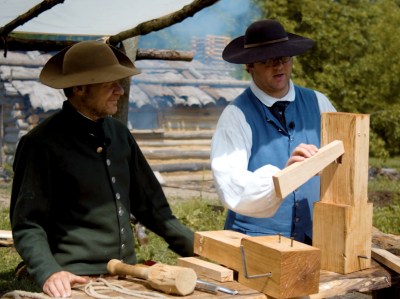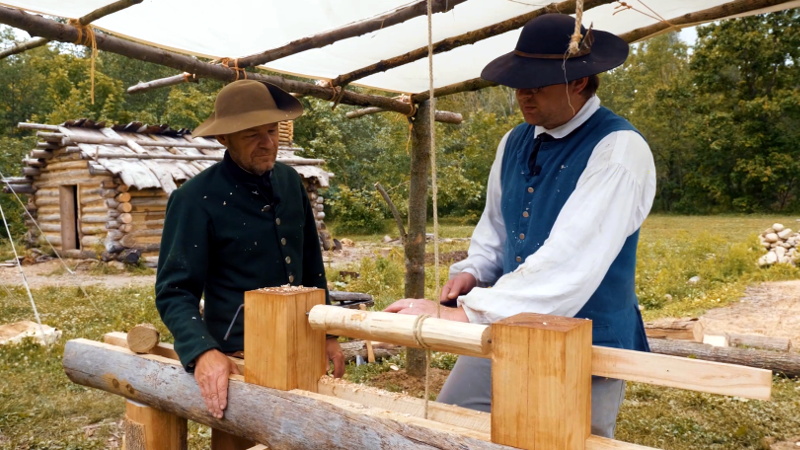We’ve seen quite a few scratch built lathes here at Hackaday, but none quite like the handcrafted pole lathe put together by [Jon Townsend] and his band of Merry Men as part of their effort to build a period-accurate 18th century log cabin homestead. With the exception of a few metal spikes here and there, everything is made out of lumber harvested from the forest around them.
The lathe is designed to be a permanent structure on the homestead, with two poles driven into the ground to serve as legs. Two rails, made of a split log, are then mounted between them. The movable components of the lathe, known as “puppets” in the parlance of the day, are cut so they fit tightly between the rails but can still be moved back and forth depending on the size of the work piece. With two metal spikes serving as a spindle, the log to be turned down is inserted between the puppets, and wedges are used to lock everything in place.
 So that’s the easy part. But how do you spin it? The operator uses a foot pedal attached to a piece of rope that’s been wound around the log and attached to a slender pole cantilevered out over the lathe. By adjusting the length and angle of this pole, the user can set the amount of force it takes to depress the pedal. When the pedal is pushed down the log will spin one way, and when the pole pulls the pedal back up, it will spin the other.
So that’s the easy part. But how do you spin it? The operator uses a foot pedal attached to a piece of rope that’s been wound around the log and attached to a slender pole cantilevered out over the lathe. By adjusting the length and angle of this pole, the user can set the amount of force it takes to depress the pedal. When the pedal is pushed down the log will spin one way, and when the pole pulls the pedal back up, it will spin the other.
Since the tools only cut in one direction, the user has to keep letting the pressure off when the log spins back around. The fact that the work piece isn’t continuously rotating in the same direction makes this very slow going, but of course, everything was just a bit slower back in the 18th century.
So now that we’ve seen lathes made from wood, intricately cut slabs of stone, and a grab bag of junkyard parts, there’s only one question left. Why do you still not have one?
















People have been using this idea for thousands of years, and it works.
There are some accurate stone columns at byblos in lebanon that must have required an immense lathe.
https://www.youtube.com/watch?v=VsuWNXV1g14
seems like it would be easier to rotate the tooling around the stones than the other way around.
At that scale, just using a cutout in wood to have template and banging with some hammers seems easier. That big tooling removing stone would have serious rigidity problems unless made from big castings.
that whole cabin build was pure 18th century hacking.
he also did a dugout canoe and a one-piece-of-bark canoe that both work really well..
Raise your hand if you’ve already seen this on The Woodwright’s Shop with Roy Underhill, back in the day.
Oh the memories! Loved that show (and the books!) growing up
I saw in person many many years ago at the county fair. I have a pair of suspenders somewhere..
I came here to see a reference to St. Roy!
Not disappointed.
In old English, a person that uses a pole lathe is known as a bodger
Aaah! I didn’t know that but came across the word. Explains the derogatory “bodge job”
Mastercraft: Greenwood on youtube will show you how to build it even easier…
https://youtu.be/QisKUt_fPPU
IMHO, it would be fairly easy getting double the action if you attached the footboard to a flywheel then the flywheel to the workpiece so you’d have continuous rotation in one direction. This technique must’ve been well-known by then. Granted, this would be easiest if you had some axles requiring a lathe, so it’s an iterative process.
Also, I wonder about the adjustible pikes. I imagine they have a screw thread but that is quite a complex thing to make – or is that available along with the nails in “general store” or something a woodworking settler would take along with them?
The whole point of the pole lathe is the simplicity of the drive mechanism of looping the cord around the piece of wood that you turn. Going for a flywheel lathe, you have to device bearings and a spinning chuck, and a ratchet, which is difficult if not impossible to make with just pieces of timber and a hatchet.
“Going for a flywheel lathe, you have to device bearings and a spinning chuck, and a ratchet, which is difficult if not impossible to make with just pieces of timber and a hatchet.”
Where’s MacGyver when you need him?
Stranded roadside, unable to fix his car.
Lathes of that type did exist around that time iirc, but were reserved for master craftsmen with a big workshop dedicated to woodworking (fine furniture and the likes). The advantage of a pole lathe like this is that it can be bodged together relatively quickly and pretty much anywhere without requiring too much in the realm of specialized tooling.
Try to construct a rudimentary lathe!
https://www.youtube.com/watch?v=QQzg1vpxnnY
(Galaxy Quest)
Looks like something you’d see at Plymoth Pantation.
I thought of using a pulley system with a big rock. Hang it with a bunch of pulleys on a tree and pull the rock up. The “falling” rock pull the rope with a steady motion until it’s on the ground. You could get a few minutes of turning if the rock is big enought.
I own a modern, variable speed lathe with all the special chucks and doodads but I still have every intention of building a spring-pole lathe for myself. It’s a completely different animal. Very satisfying.
Very cool.
I made one of these when I was 16 after watching Roy Underhill give a demo in Williamsburg.
Although, I cringe when I see people use a cutting device like a gouge or skew as a scrapper. Dulls the blade quick and creates a shitty finish.